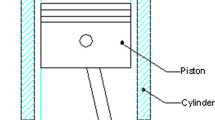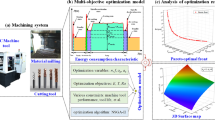Abstract
With the advent use of sophisticated and high-cost machines coupled with higher labor costs, concurrent optimization of machining process parameters and tolerance allocation plays a vital role in producing the parts economically. In this paper, an effort is made to concurrently optimize the manufacturing cost of piston and cylinder components by optimizing the operating parameters of the machining processes. Design of experiments (DoE) is adopted to investigate systematically the machining process parameters that influence product quality. In addition, tolerance plays a vital role in assembly of parts in manufacturing industries. For the selected piston and cylinder component, improvements efforts are made to reduce the total manufacturing cost of the components. By making use of central composite rotatable design method, a module of DoE, a mathematical model is developed for predicting the standard deviation of the tolerance achieved by grinding process. This mathematical model, which gives 93.3% accuracy, is used to calculate the quality loss cost. The intent of concurrent optimization problem is to minimize total manufacturing cost and quality loss function. Genetic algorithm is followed for optimizing the parameters. The results prove that there is a considerable reduction in manufacturing cost without violating the required tolerance, cutting force, and power.
Similar content being viewed by others
References
Mukherjee I, Ray PK (2006) A review of optimization techniques in metal cutting process. Comput Ind Eng 50:15–34
Cus F, Balic J (2003) Optimization of cutting process by GA approach. Robot Comput Integr Manuf 19:113–121
Saravanan R, Ashokan P, Vijayakumar K (2003) Machining parameters optimization for turning cylindrical stock into a continuous profile using genetic algorithm(GA) and simulated annealing. Int j Adv manuf Technol 21:1–9
Shunmugam MS, Bhaskara Reddy SV, Narendran TT (2000) Selection of optimal conditions in multi-pass face—milling using a genetic algorithm. Int J Mach Tools Manuf 40:401–414
Aggarwali A, Singh H (2005) Optimization of machining techniques—a retrospective and literature review. S¯adhan¯a 30(6):699–711
Kakir MC, Garuda A (2000) Optimization of machining conditions for multi tool milling operations. Int J Prod Res 38(15):3537–3552
Saravanan R, Asokanand P, Schithanandham M (2001) Comparative analysis of conventional and non-conventional optimization techniques for CNC turning process. Int j Adv manuf Technol 17:471–476
Li XP, Nee AYC, Wong YS, Zheng HQ (1999) Theoretical modeling and simulation of milling forces. J Mater Process Technol 89–90:266–272
Deb K (1995) Optimization for engineering design. Prentice Hall of India, New Delhi
Boothroyd G (1989) Fundamentals of metal machining and machine tools. McGraw-Hill Ltd, New York
Rao SS (1996) Engineering optimization-theory and practice, 3 edn. New Age International (p) Limited, New Delhi
Saravanan R (2006) Manufacturing optimization through intelligent techniques. CRC, Boca Raton FL
Abburi NR, Dixit US (2007) Multi-objective optimization of multipass turning processes. Int J Adv Manuf Technol 32:902–910
Karpat Y, Özel T (2007) Multi-objective optimization for turning processes using neural network modeling and dynamic-neighborhood particle swarm optimization. Int J Adv Manuf Technol 35:234–247
Sardinas RQ, Santana MR, Brindis EA (2006) Genetic algorithm-based multi-objective optimization of cutting parameters in turning processes. Eng Appl Artif Intell 19:127–133
Capello E, Semeraro Q (2002) Process parameters and residual stresses in cylindrical grinding. ASME J Manuf Sci Eng 124(3):615–623
Xiao G, Malkin S (1996) On-line optimization for internal plunge grinding. C IRP Ann 45:351–356
Shunmugam MS, Reddy SV, Narendran TT (2000) Optimal selection of parameters in multi-tool drilling. J Mater Process Technol 1032:318–323
Kusiak A, Feng CX (1996) Robust tolerance design for quality. ASME J Eng Ind 118(1):166–169
Feng CX, Kusiak A (1997) Robust tolerance design with the integer programming approach. ASME J Manuf Sci Eng 11 9(4A):603–610
Feng CX, Kusiak A (2000) Robust tolerance design with the design of experiments approach. ASME J Manuf Sci Eng 122(3):520–528
Anwarul M, Liu MC (1995) Optimal manufacturing tolerance: the modified taguchi approach. In Proceedings of the 4th Ind Eng Res Conf Nashville, USA 379–383
Choi H-GR, Park M-H, Salisbury E (2000) Optimal tolerance allocation with loss function. ASME J Manuf Sci Eng 122:273–281
Li MH (2000) Quality loss function based manufacturing process setting models for unbalanced tolerance design. Int J Adv Manuf Technol 16(1):39–45
Li MH (2002) Unbalanced tolerance design and manufacturing setting with asymmetrical linear loss function. Int J Adv Manuf Technol 20(5):334–340
Ngoi BKA, Ong CT (1993) A complete tolerance charting system. Int J Prod Res 31(2):453–469
Ngoi BKA, Fang SL (1993) Computer aided tolerance charting. Int J Prod Res 32:1939–1954
Ji P (1993) A linear programming model for tolerance assignment in a tolerance chart. Int J Prod Res 31(3):739–751
Shirai E (1982) The metal cutting and grinding processes. In: Gao X, Liu D (eds) Chinese. Machinery Industry, Beijing
Meng S (ed) (1996) Handbook of metal cutting processes. Machinery Industry, Beijing
Malkin S (1989) Grinding technology: theory and application of machining with abrasives. Ellis Hzrwood Limited, Chichester
Zhao R (1992) Handbook for machinists. Shanghai Science and Technology, Shanghai
Wang P, Liang M (2005) Simultaneously solving process selection, machining parameter optimization, and tolerance design problems: a bi-criterion approach. J Manuf Sci Eng 127:533–544
Kurodaa M, Marrowa TJ (2008) Preparation of fatigue specimens with controlled surface characteristics. J mater process technol 203:396–403
Palanikumar K (2007) Modeling and analysis for surface roughness in machining glass fibre reinforced plastics using response surface methodology. Mater Des 28:2611–2618
Agapiou JS (1992) The optimization of machining operations based on a combined criterion, Part 1: the use of combined objectives in single pass operations. Trans ASME, J Eng Ind 114:500–507
Agapiou JS (1992) The optimization of machining operations based on a combined criterion, part 2: multipass operations. Trans ASME, J Eng Ind 114:508–513
Ermer DS (1971) Optimization of the constrained machining economics problem by geometric programming. Trans ASME, J Eng Ind 93:1067–1072
Gopalakrishnan B, Al-Khayyal F (1991) Machine parameter selection for turning with constraints: an analytical approach based on geometric programming. Int J Prod Res 29:1897–1908
Mesquita R, Krasteva E, Doytchinov S (1995) Computer-aided selection of optimum parameters in multi-pass turning. Int J Adv Manuf Technol 10:19–26
Draghici G, Paltinea C (1974) Calculation by convex mathematical programming. Int J Mach Tool Res 14:143–160
Author information
Authors and Affiliations
Corresponding author
Rights and permissions
About this article
Cite this article
Janakiraman, V., Saravanan, R. Concurrent optimization of machining process parameters and tolerance allocation. Int J Adv Manuf Technol 51, 357–369 (2010). https://doi.org/10.1007/s00170-010-2602-x
Received:
Accepted:
Published:
Issue Date:
DOI: https://doi.org/10.1007/s00170-010-2602-x




